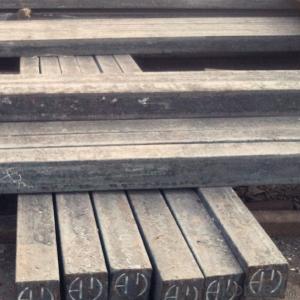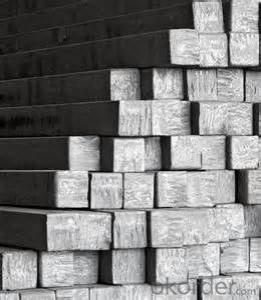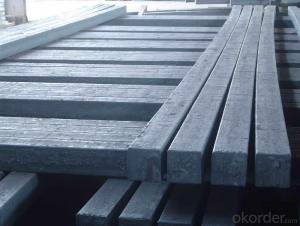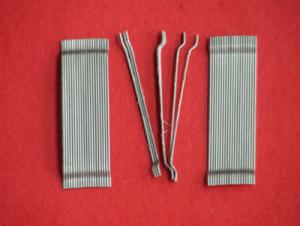Hot Sale Q235 130*130 Steel Square Billet 3sp China
- Loading Port:
- China main port
- Payment Terms:
- TT OR LC
- Min Order Qty:
- 20 m.t.
- Supply Capability:
- 10000 m.t./month
OKorder Service Pledge
OKorder Financial Service
You Might Also Like
Specification
Specifications
1.Grade: 3SP, 5SP, Q195, Q235, Q195, Q275
2.Terms of payment: TT or L/C at sight
3.Size: 60*60mm-150*150mm
4.Length: 5.8~12m
Product Description
Type | Steel billet |
Standard Grade | a. 3SP/PS |
b. Q235 | |
c. 5SP d. Q275 | |
Size | 120mm x 120mm-150mm x 150mm etc. as per customers' requirement |
Length | 12m as standard |
Application | Carbon structural steel, Alloy steel, Gear steel, etc. |
Packing | standard export packing, or as per customers' requirement |
Quality | First quality |
Delivery time | Right now after the deposit. |
Others | 1. our products conform to all the standards |
2. we can offer special specification products as per our customers | |
3. we can offer the original mill test certificate and original production |
Chemical composition:
| Standard | C(%) | Mn(%) | S(%) | P(%) | Si(%) |
| Q195 | ≤0.12 | ≤0.50 | ≤0.040 | ≤0.035 | ≤0.30 |
| Q235 | ≤0.20 | ≤1.40 | ≤0.045 | ≤0.045 | ≤0.35 |
| Q275 | ≤0.22 | ≤1.50 | ≤0.045 | ≤0.045 | ≤0.35 |
| 20MnSi | 0.17-0.25 | 1.2-1.6 | ≤ 0.050 | ≤ 0.050 | 0.40-0.80 |
| 3SP | 0.14-0.22 | 0.40-0.85 | ≤ 0.050 | ≤ 0.040 | 0.05-0.15 |
| 5SP | 0.28-0.37 | 0.50-1.00 | ≤ 0.050 | ≤ 0.040 | 0.15-0.30 |
Other Products We Do
l hot rolled coil/plate
l cold rolled coil/plate
l galvanized \ galvalume coil
l PPGI/PPGL
l Corrugated sheet (roof sheet, wall sheet, decking sheet )
l steel pipes ( galvanized, seamless, welded pipe )
l profiled bars (H beam/ I beam/ Angle/ Channel/)
l steel structure warehouse
l steel products processing
l hot dip galvanized brackets
l round irrigation equipment
l field master linear irrigation equipment
l side roll sprinkler
l reel sprinkling irrigation equipment
l sprinkling irrigation machinery
l fixed and transportable sprinkler
l drip irrigation micro-spray series

- Q: How is steel used in the production of medical devices?
- Steel is used in the production of medical devices due to its strength, durability, and biocompatibility. It is commonly used in surgical instruments, implants, and orthopedic devices, providing a reliable and long-lasting material for these critical applications.
- Q: What are the different types of steel tubes and their uses?
- There are several types of steel tubes, including seamless, welded, and ERW (Electric Resistance Welded) tubes. Seamless tubes are made without any welding or joints and are used in high-pressure applications like oil and gas pipelines. Welded tubes are manufactured by bending and welding steel plates or strips and are commonly used in construction, automotive, and furniture industries. ERW tubes are made by passing a high-frequency current through the metal, producing a welded seam, and are used in structural and mechanical applications. Furthermore, there are specialized types of steel tubes such as square, rectangular, and round tubes, each serving specific purposes in various industries.
- Q: How is steel used in the construction of bridges?
- Steel is commonly used in the construction of bridges due to its high strength and durability. It is used in the fabrication of beams, girders, and trusses, providing crucial support and load-bearing capacity. Steel's flexibility allows for the creation of various bridge designs, including arches, suspension, and cable-stayed bridges. Additionally, steel's corrosion resistance and ability to withstand extreme weather conditions make it an ideal material for bridge construction, ensuring the longevity and safety of these vital structures.
- Q: How are steel plates used in the fabrication of storage silos?
- Steel plates are used in the fabrication of storage silos as they provide strength, durability, and corrosion resistance necessary for containing and storing various materials. These plates are formed, welded, and assembled to create the cylindrical structure of the silo, ensuring it can withstand the weight of the stored materials and any external forces.
- Q: What are the different types of steel fasteners and their uses in the marine industry?
- There are several types of steel fasteners commonly used in the marine industry. Some of the most common ones include stainless steel bolts, screws, and nuts. These fasteners are highly resistant to corrosion, making them ideal for use in marine environments where they are exposed to saltwater and moisture. They are often used to secure various components of a boat or ship, such as railings, cleats, and fittings. Additionally, steel fasteners like snap hooks and shackles are used to connect ropes and chains, providing reliable and secure connections in the marine industry.
- Q: What are the different types of steel fasteners and their applications?
- There are several different types of steel fasteners commonly used in various applications. Some of the most common types include bolts, screws, nuts, and washers. Bolts are threaded fasteners that are used to join two or more components together. They come in different sizes and strengths, making them suitable for a wide range of applications such as construction, automotive, and machinery. Screws are similar to bolts but have pointed ends and are typically used to secure objects to a surface or to hold components together. Nuts are threaded fasteners that are used in conjunction with bolts to create a secure joint. They provide additional stability and can be easily tightened or loosened. Washers are flat, disk-shaped fasteners that are placed between a nut or bolt head and the surface of the material being fastened. They help distribute the load and prevent damage to the material. Overall, steel fasteners are essential components used in various industries for their strength, durability, and versatility.
- Q: What are the uses of steel in the construction of airports?
- Steel is widely used in the construction of airports due to its strength, durability, and versatility. It is used for various purposes such as structural framing, roofing, cladding, and reinforcement. Steel provides the necessary strength to support the weight of the airport's infrastructure, including runways, terminals, hangars, and control towers. It also offers resistance against extreme weather conditions and can be easily fabricated and customized to meet the specific design requirements of an airport. Overall, steel plays a crucial role in ensuring the safety, longevity, and functionality of airport structures.
- Q: How are steel products used in the construction of high-rise buildings?
- Steel products are extensively used in the construction of high-rise buildings due to their superior strength, durability, and flexibility. Steel is commonly employed for structural frameworks, beams, columns, and reinforcement in high-rise construction. Its high strength-to-weight ratio allows for taller and lighter buildings, while its flexibility enables architects to design complex and innovative structures. Additionally, steel's resistance to fire, earthquakes, and adverse weather conditions makes it a reliable choice for ensuring the safety and stability of high-rise buildings.
- Q: How do steel products contribute to the construction of data centers and IT facilities?
- Steel products play a significant role in the construction of data centers and IT facilities by providing structural support, durability, and safety. Steel is widely used in the construction of the building's framework, ensuring the facility can withstand the weight of heavy equipment and support the complex infrastructure required for data storage and processing. The use of steel also allows for flexible and scalable designs, accommodating future expansions or modifications. Additionally, steel's fire-resistant properties help protect critical IT equipment from potential hazards, making it an essential component in ensuring the reliability and security of data centers and IT facilities.
- Q: What are the properties of abrasion-resistant steel for industrial equipment?
- Abrasion-resistant steel for industrial equipment possesses several key properties. Firstly, it has excellent hardness, making it resistant to wear and tear caused by constant friction and impact. Additionally, it exhibits high strength, enabling it to withstand heavy loads and extreme conditions. This type of steel also has exceptional toughness, allowing it to endure harsh environments without cracking or breaking. Furthermore, it possesses good weldability, facilitating easy fabrication and maintenance. Overall, abrasion-resistant steel ensures prolonged equipment lifespan, reduced downtime, and increased productivity in industrial settings.
Send your message to us
Hot Sale Q235 130*130 Steel Square Billet 3sp China
- Loading Port:
- China main port
- Payment Terms:
- TT OR LC
- Min Order Qty:
- 20 m.t.
- Supply Capability:
- 10000 m.t./month
OKorder Service Pledge
OKorder Financial Service
Similar products
Hot products
Hot Searches
Related keywords


























